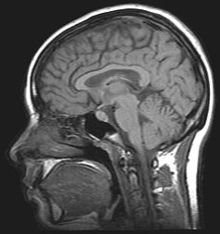Study claims to show difference between male and female brains
Wednesday, February 16, 2005

Michael Gurian, psychologist and author of "What Could He Be Thinking?", has claimed to identify approximately one hundred structural differences between male and female brains in a recent study. Gurian comments:
- "Men, because we tend to compartmentalize our communication into a smaller part of the brain, we tend to be better at getting right to the issue, the more female brain (will) gather a lot of material, gather a lot of information, feel a lot, hear a lot, sense a lot."
One major structural difference that Gurian has made clear is that males generally have more activity in the mechanical centers of the brain, while women have more activity in centers of the brain dedicated to verbal communication and emotion. A clear example of this is the hypothetical situation of giving a child a toy. He explains it as such:
- "That doll becomes life-like to that girl, but you give it to a two-year-old boy and you are more likely, not all the time, but you are more likely than not to see that boy try to take the head off the doll. He thinks spatial-mechanical. He's using the doll as an object."
Another expert, Dr. Marianne Legato, says it all boils down to genetics, noting that the Y chromosome (which only males carry) has "at least 21 unique genes unique to males which control many of the body's operations down to the level of the cells."
Gurian agrees that culture is significant in brain development, but argues that biology plays an equally important role. He makes a point of how the MRI scans show that the female corpus callosum, the center of the brain which regulates communication between the brain's hemispheres, is larger than the male's. On the other hand, the scans also show that information flows more freely between the hemispheres of the male brain.
The exact role that brain structure plays in behavior, however, has been an area of considerable contention in science for literally hundreds of years. Early studies in craniometry conducted by Paul Pierre Broca were used to attempt to distinguish differences between human races, though have now been dismissed as scientific racism. The nature-nurture debate has raged for centuries in a variety of forms, without yet any clear resolution as to the role in which innate biological tendencies interact with environmental conditions or willed behavior. As such, studies relating to brain structure and claims to innate behavior often generate substantial controversy.
MIT anthropologist of science Joseph Dumit's study of brain imaging in his book Picturing Personhood: Brain Scans and Biomedical Identity, noted that the apparent "transparency" of such pictures (the appearance that they can be easily interpreted by laymen, when they are often the source of ambiguity and dispute by even highly-trained neurosurgeons) has led to their proliferation as indicators of objective truth in media and in courts of law, and that such conclusions are often knowingly exaggerated by the specialists creating the images for better visual effect.
The timing of Gurian's book comes on the heels of another controversy over gender differences sparked by comments made by Harvard president Lawrence Summers, who blamed low numbers of women in the sciences on genetic differences. Summers has been criticized by a large number of academics and scientists, as well as by many news publications, in the wake of what he was reported as saying during a conference on January 14.
Sources
edit- Marcella Bombardieri. "Summers releases debated transcript" — Boston Globe, February 18, 2005
- "New book offers clues to male brain" — MSNBC, February 15, 2005
- "Brainpower as easy as X and Y" — CNN, February 15, 2005